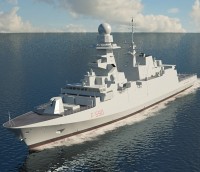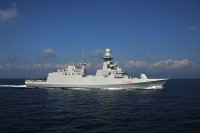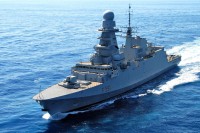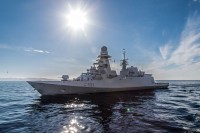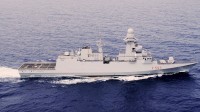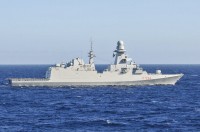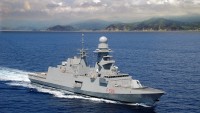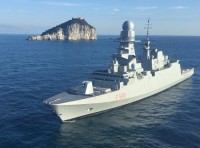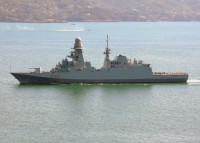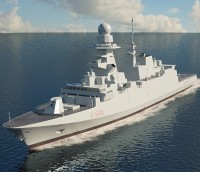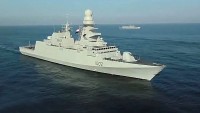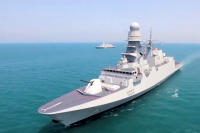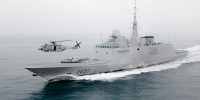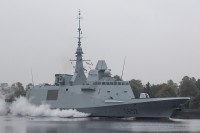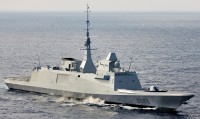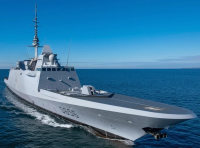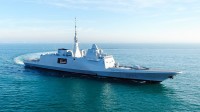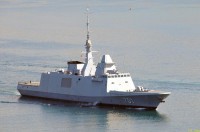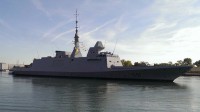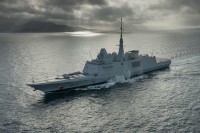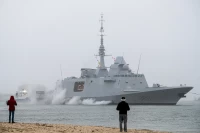Фрегати проєкту FREMM
Основна інформація
The FREMM («European multi-purpose frigate»; French: Frégate européenne multi-mission; Italian: Fregata europea multi-missione) is a class of multi-purpose frigates designed by Naval Group/Armaris and Fincantieri for the navies of France and Italy. The lead ship of the class, Aquitaine, was commissioned in November 2012 by the French Navy. In France the class is known as the Aquitaine class, while in Italy they are known as the Bergamini class. Italy has ordered six general purpose variants and four anti-submarine variants; the last two Italian general purpose FREMMs will have anti-aircraft warfare, anti-ballistic missile and surface attack capabilities. France has ordered six anti-submarine variants, and two air-defence variants. The class is one of the five finalists for the U.S. Navy’s FFG(X) program.
Three original variants of the FREMM were proposed; an anti-submarine variant (ASW) and a general-purpose variant (GP) and a land-attack variant (AVT) to replace the existing classes of frigates within the French and Italian navies. A total of 27 FREMM were to be constructed — 17 for France and 10 for Italy — with additional aims to seek exports, however budget cuts and changing requirements has seen this number drop significantly for France, while the order for Italy remained invaried. The land-attack variant (AVT) was subsequently cancelled.
A third anti-air warfare variant of FREMM was proposed by DCNS in response to French requirements for a new air-defence frigate, the new variant became known as FREDA («FREgates de Défense Aériennes», «Air defence frigate»). This new French requirement was due to the third and fourth Horizon-class frigates being cancelled after the first two cost €1.35B each, but this decision left French Navy still in-need of replacements for its ageing Cassard-class air-defence frigates.
As of 2009, the FREDA design features a more powerful version of the Herakles (radar) passive electronically scanned array radar and 32 cells of SYLVER A50 in place of the 16 cells of A43 and 16 cells of A70. The SYLVER A50 would allow it to fire the 120 kilometres (75 mi)-range Aster 30 missile; the towed array sonar would not be fitted.
At Euronaval 2012 DCNS showed a new concept called FREMM-ER for the FREDA requirement, again based on the FREMM, but specifically mentioning the ballistic missile defence mission as well as anti-air. FREMM-ER has a modified superstructure replacing Héraklès with the new Thales Sea Fire 500 radar, whose four fixed plates resemble those of the US Navy's AN/SPY-1. However unlike the Héraklès and the SPY-1 (both using passive electronically scanned array technology), the Sea Fire 500 has active electronically scanned array antennas.
France
Original plans were for 17 FREMM to replace the nine D'Estienne d'Orves-class avisos and nine anti-submarine frigates of the Tourville and Georges Leygues classes. In November 2005 France announced a contract of €3.5 billion for development and the first eight hulls, with options for nine more costing €2.95 billion split over two tranches (totaling 17).
Following the cancellation of the third and fourth of the Horizon-class frigates in 2005 on budget grounds, requirements for an air-defence derivative of the FREMM called FREDA were placed – with DCNS coming up with several proposals. Expectations were that the last two ships of the 17 FREMM planned would be built to FREDA specifications; however, by 2008 the plan was revised down to just 11 FREMM (9 ASW variants and 2 FREDA variants) at a cost of €8.75 billion (FY13, ~US$12 billion). The 11 ships would cost €670 million (~US$760m) each in FY2014, or €860m (~US$980m) including development costs.
The 2013 White Paper on Defence and National Security committed France to 15 front-line frigates, which was initially interpreted as 2 Horizons, 5 La Fayettes and a reduction in the FREMM fleet down to 8 ships. The 2014/2019 defence plan restated a target of 11 frigates; the current plan is to deliver six ASW FREMM variants to replace the Georges Leygues-class frigates by 2019, followed by two anti-air variants to replace the ageing Cassard-class frigates and a decision will be taken in 2016 on what version the remaining three will be. In 2014, the French Navy's Chief of Staff, Adm. Bernard Rogel, confirmed that 11 FREMM frigates had been ordered but in 2015 the order was cut to 8 in order to allow the purchase of five FTI Mid-Size frigates from 2023. The FTI will replace the La Fayette-class class, which will be fitted with a sonar as an interim measure.
Italy
Planning assumptions for the Italian Navy are 10 FREMM-IT (4 ASW variants and 6 GP variants) at a cost of €5.9 billion. FREMM-IT will replace the Maestrale and Lupo-class frigates in service with the Italian Navy.
In the 2013 Italian budget, the Italian government laid out the necessary financing for two more GP variants (FREMM-IT 7 & 8) and the contract was awarded in September 2013. On 15 April 2015, the Italian Parliament confirmed the deal between OCCAR and Orizzonte Sistemi Navali Spa (Fincantieri and Finmeccanica, since 2017 Leonardo) to begin building units 9 and 10, for 764 million Euros.
As of 16 April 2015, the Italian government has approved funding for all ten FREMM-IT to be delivered to the Italian Navy (4 ASW variants and 6 GP variants).
FREMM-IT 9 & 10 will have undisclosed enhanced capabilities.All 10 Italian FREMM-ITs have extended AAW capabilities, with SAAM-ESD CMS and Aster 30 (& Aster 15) missiles for extended area defence.SAAM-ESD CMS use Leonardo MFRA, a 3D active radar (AESA), an evolved version of the Leonardo EMPAR PESA radar (previously embarked on Horizon-class destroyers and the aircraft carrier Cavour).Since the 7th FREMM-IT, there will be updates, such as new conformal IFF antenna and much more stealth response.Since the 9th FREMM-IT, should be updates to other systems:
the COC and bridge will be integratedthe cruise speed will be enhanced to 19/20 knots (with more powerful diesel engines)would be fitted with Leonardo ATAS VDS sonar and SLAT anti-torpedo systemIn 2017 the Italian FREMM refit started with the installation on each of 2 SITEP MS-424 acoustic guns.
Morocco
On 24 October 2007 it was announced that the Royal Moroccan Navy had ordered one FREMM to replace its Descubierta-class corvette. The contract was signed on 18 April 2008 and construction of the Moroccan FREMM began in the summer 2008 with delivery expected in 2012 or 2013; Mohammed VI was launched in September 2011 and handed over on 30 January 2014. The Moroccan ship is similar to the French anti-submarine version, without SYLVER A70 tubes for SCALP Naval, and cost €470m.
Egypt
On 16 February 2015, The Egyptian Navy ordered one FREMM vessel to enter service before the opening of the New Suez Canal, as part of a larger deal (including 24 Rafales and a supply of missiles) worth US$5.9 billion (€5.2 billion). In order to keep to Egypt's deadlines, France offered to send Normandie, originally intended for the French Navy. The SYLVER A70 VLS and NETTUNO-4100 jamming equipment were removed due to export limitations for such sensitive equipment. The crew will be around 126 sailors compared to 108 in the French Navy. The SATCOM antenna for the French Syracuse satellites was also taken down; however, Egypt will use its own military telecommunications satellite, supplied by Airbus Defence and Space and Thales Alenia Space, in conjunction with its naval vessels. From March 2015, DCNS trained the Egyptian crew in the technology of the ship and DCNS and its partners accompanied the crew for a period of 15 months. On 23 June 2015, French naval shipbuilder DCNS transferred the FREMM frigate Tahya Misr (ex-Normandie) to the Egyptian navy. A ceremony took place to transfer Normandie, renamed Tahya Misr («Long Live Egypt») to Egypt, in the presence of General Sedki Sobhy, the Egyptian Minister of Defense, Jean-Yves Le Drian, the French Minister of Defense, Admiral Osama Rabie, Egyptian Navy Commander in Chief, Admiral Bernard Rogel, the French Chief of Navy and Hervé Guillou, Chairman & CEO of DCNS.
United States
On 30 April 2020, the US Navy announced that Fincantieri had been awarded a $795 million contract for the lead ship, to be built at Fincantierri Marinette Marine in Marinette, Wisconsin. The contract includes options for an additional nine ships, which, if all options were exercised, would value the contract at $5.5 billion.
Кораблі22
- Коментарі
 uk
uk en
en ru
ru
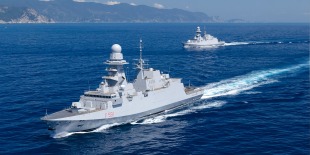
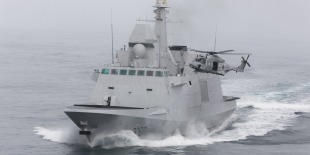
 Військово-морські сили Італії
Військово-морські сили Італії Королівські військово-морські сили Марокко
Королівські військово-морські сили Марокко Військово-морські сили Єгипту
Військово-морські сили Єгипту Військово-морські сили Франції (Marine Nationale)
Військово-морські сили Франції (Marine Nationale) Fincantieri
Fincantieri Naval Group (formerly DCNS)
Naval Group (formerly DCNS)